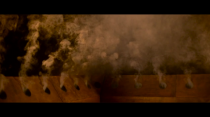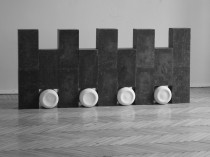On IRAN DO ESPIRITO SANTO
Ingleby Gallery, Until 25th September 2010
On seeing Iran do Espirito Santo’s exhibition at Ingleby, a friend commented that the work had ‘no temperature’. At the time this laconic remark was heeded unquestioningly, seeming as it did, to surmise the work on show with a concise precision. Only later did I considered the potential implication of such a response- what is it to be without temperature? Is it comparable to lacking a pulse? Or even being devoid of a heart?
Using a stark, minimal palette of black, white and intermittent shades of grey, Espirito Santo’s sculptural objects, photograms and wall-painted works are executed with a clinical precision- free from trace of human hand or emotional expression. He plays with contrasts and contradictions; razor-sharp lines sit alongside fuzzy edges, some surfaces reflect, others absorb and certain works treat the permanent with temporary gesture whilst others bestow permanence on the ephemeral.
Two photogram series demonstrate his scientific sensibility- seven different shades of grey resulting from staggered exposure times make-up Standby, whilst Twist depicts a quintet of identical sheets of paper, folded five separate ways to create a series of distinct new forms. Pencil graphite has then been applied to add a further grey shade to the fractured geometric shapes- creating a cryptic tonal interplay across the series. Photograms, created by placing objects directly onto the surface of photosensitive paper before exposing them to light, were famously utilised by Man Ray in the 1920s. However, whilst his Dadaist predecessor playfully explored the arbitrary potential of the medium by adding and moving objects around mid-exposure, Espirito Santo employs a far more rigid, controlled approach. Exposure times are calculated and recorded, and shapes and tones meticulously measured, in order to produce results that appear to have been pre-determined far in advance.
Sitting proudly at the gallery entrance is the exhibition’s poster-boy, Water Glass. An item of exceptional, austere beauty- it sits like a rare, untouched gem upon its white plinth. On closer inspection however, the glass, apparently filled to the brim, appears impossibly perfect– causing critical suspicions over the integrity of what its title claims it to be. By revealing it to be solid crystal, the exhibition floor plan decisively and disappointingly shatters its intriguing ambiguity (further disappointment regarding its presumed rarity is to be had in discovering that, as one of an edition of 25, it has 24 identical twins being admired elsewhere).
This procedure of taking banal, domestic items and transforming them into precious objects of desire recurs in the artists practice; an awkwardly outsized pencil formed in stainless steel lies discreetly upstairs, whilst further works see lightbulbs cast in solid glass and tin cans enlarged and finished with black gloss. In creating these preserved representations, he bestows an alternative value upon these familiar forms and a practical lifespan far greater than their traditional expectancy. However, this immortalisation process also effectively robs the object of its fundamental function, creating in it a sense of melancholic redundancy- turning it into an impotent fetish; a pencil that can’t write, a frozen lightbulb that doesn’t light, a glass that won’t pour.
En Passant 5, a dramatic gradated greyscale wall-painting encompasses the entire first floor gallery space. Created by a team of assistants over the course of two weeks, the works consists of one horizontal and three vertical striped walls. Evocative of Robert Irwin and Michael Asher, it embodies established minimalist principles, creating in the viewer a heightened awareness of the relationship between the work and the environment in which it is shown- as well as their own self in relation to both the work and the space. The human endeavour that went into its production is belied by the mechanical precision and consistency of its final appearance and any domestic warmth of the household paint is lost in its harsh industrial pallor.
Espirito Santo’s work has a cool, slick elegance that whilst proving alluringly seductive, initially seems ultimately primed to deliver a cold-shoulder.
But then the natural light outside shifts.
A new sun causes the walls upstairs to dance and ebb producing an effect that both destabilizes and thrills- elsewhere an ember of vivid light refracts in the crystal glass. It becomes clear that the artist has consciously considered and employed light, not only as a producer, but also as an ongoing catalyst to alter and affect the work after its completion. It is perhaps this factor that gives the work life and temperature- provided, that is, you’re in the right place at the right time to see it.















Comments